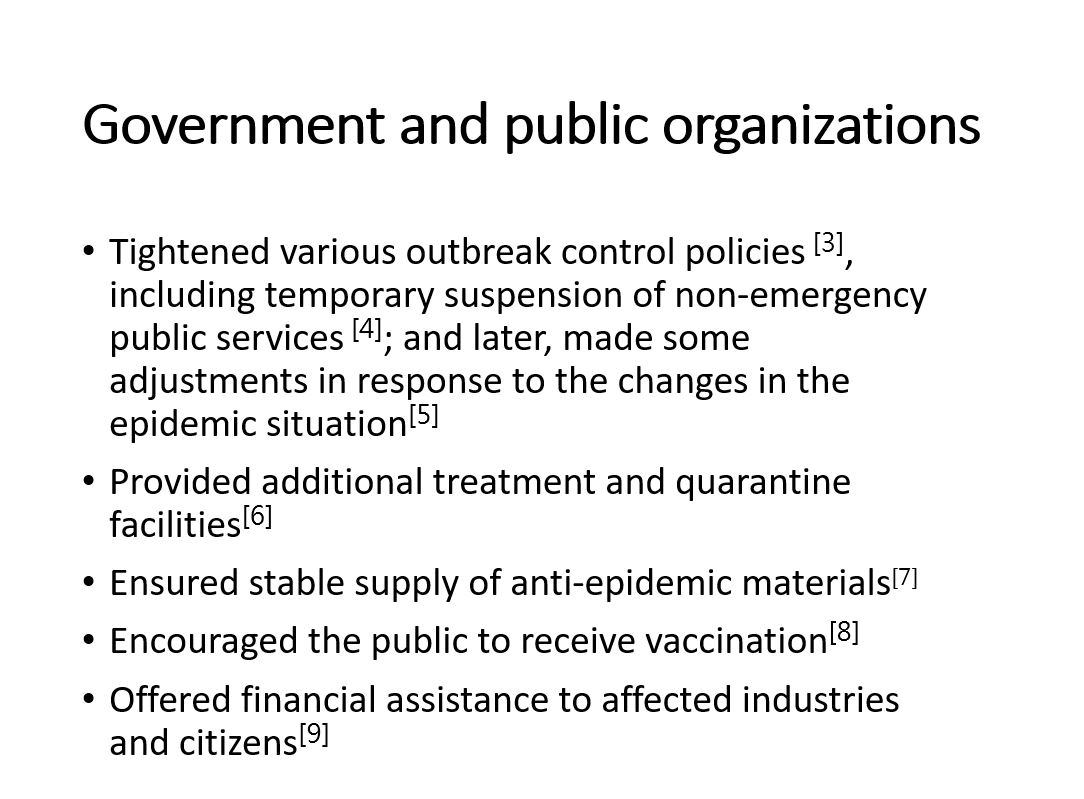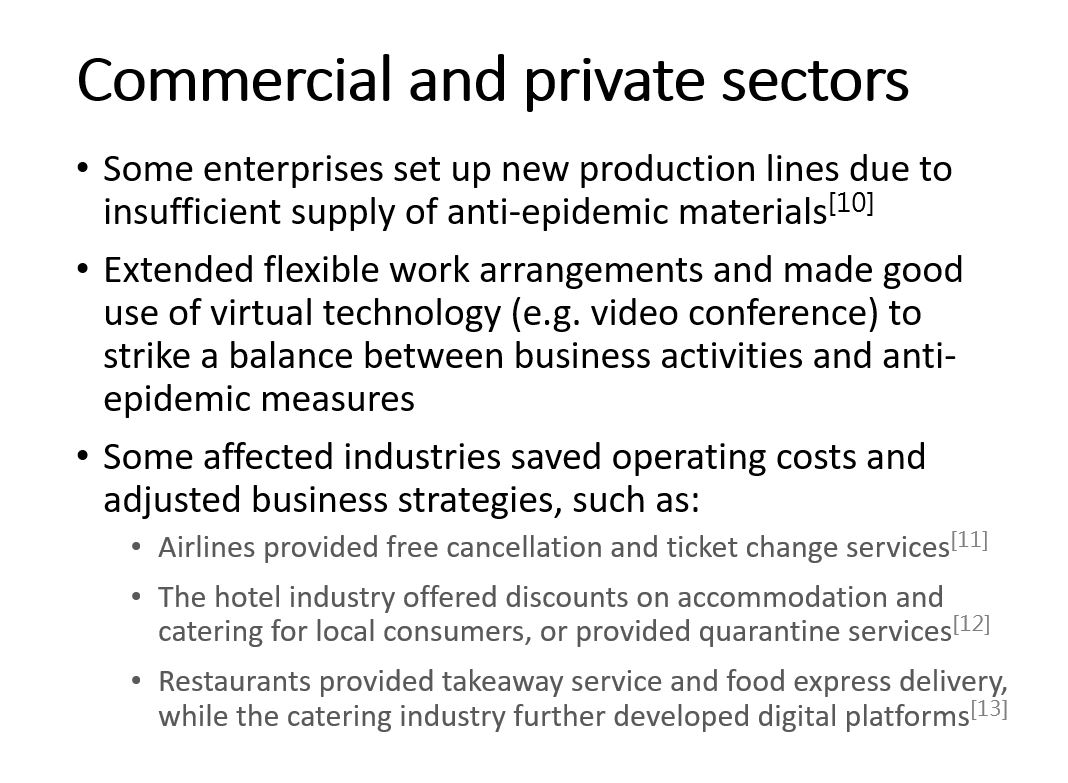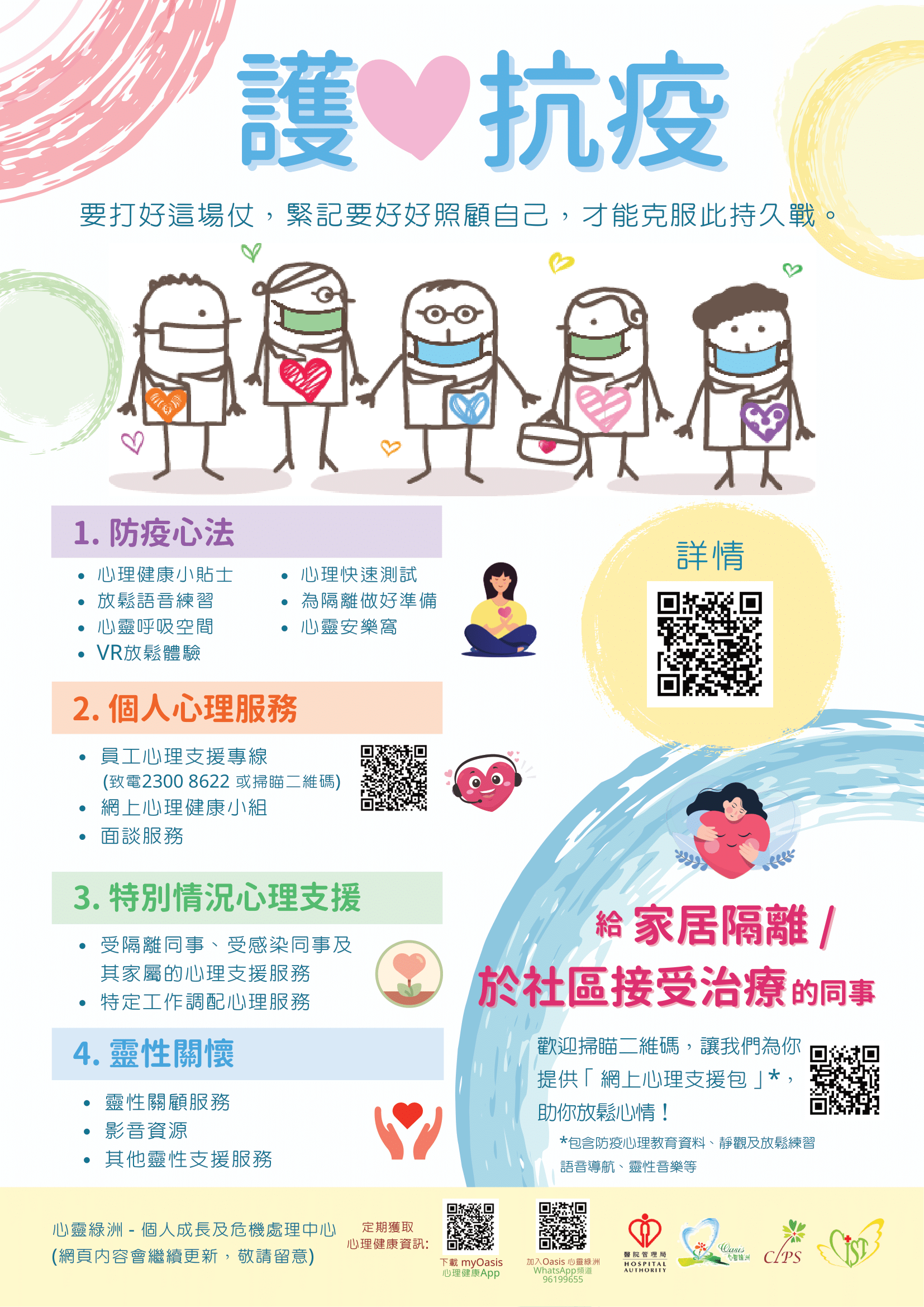 Chapter 2:Response Phase
Chapter 2:Response Phase
With the emergence of the first case of local infection, Hong Kong had to continuously guard against imported cases from abroad, while striving to cut the community transmission chains and to avoid the healthcare system from being overloaded. The epidemic situation in Hong Kong had been fluctuating, and the loopholes in disease prevention were located and fixed with experience from different clusters of infected cases[1][2]. Still, the pandemic continued to ravage the world and new variants of the virus appeared one after another. People gradually realized that they were to face a long-running battle against the epidemic, and began to think about long-term and sustainable strategies, such as:

Government and public organizations

Commercial and private sectors
However, as the battle against the epidemic went on, the mental health of citizens was observed to be affected. Here were some of the factors that might lead to negative emotions and hence affect people’s physical and mental health:
| Restrictions brought by the epidemic and response measures |
Impacts on daily life and mental health |
| Economic downturn and rising unemployment rate |
Financial burdens and work pressure[14]
|
| Social distancing |
Decreased Life satisfaction due to restricted Interpersonal communication[15][16]
|
| Long-term home quarantine |
Physically inactive and sedentary lifestyle increased conflicts between family members and physically inactive and sedentary lifestyle due to limited space for activities[17]
|
| Restrictions on public services and facilities such as schools, support services for children, residential care homes, and medical care services |
Less support for caregivers and difficulties in work due to caretaking of family members in need[18]
|
A study revealed that after experiencing the social events in 2019 and the unprecedented epidemic following by, more than 40% of the Hong Kong respondents reported symptoms of depression, anxiety and post-traumatic stress disorder[19]. More than 25% of the respondents from another study stated that their mental health had deteriorated since the outbreak of epidemic[20]. The surge in the number of school case referrals after the resumption of face-to-face classes also reflected that children’s mental health problems and family issues were increasingly severe during the epidemic[21].
Health care professionals were at the forefront of the fight against the epidemic for an extended period of time. They faced a high risk of infection at work and were subject to stricter measures on personal protection and infection control. Therefore, they inevitably accumulated much pressure. Some overseas studies pointed out that health care professionals were more susceptible to mental health problems[22] and burnout[23], which affected their personal health and work performance.
Lessons learned
The above review reflects that during the epidemic, the public's need for certain public services may be more pressing than usual[24][25]. Certainly, suspending all non-emergency public services in the early stage of the epidemic did help curb the outbreak in the community. However, when the fight against the epidemic extended, it was important to redefine what "essential" public services are. Some public services on the premise of meeting the requirements of disease prevention might be resumed in order to strike a balance between outbreak control and the public's mental health. Various institutions might also take this as an opportunity to explore new service models, for example, the development of contactless services or telecare.

Some HA clinics provided video consultation to patients through mobile app
Furthermore, the mental health of the public has to be taken into account while formulating long-term anti-epidemic measures. In fact, government departments including the Social Welfare Department, as well as a number of non-governmental organizations, successively launched different helplines, community services and the resources related to disease prevention and mental health, so as to help citizens in need get through the pandemic.
In addition to the government and social welfare service providers, enterprises, schools and the private sector could also put effort into formulating long-term contingency plans, such as paying more attention to the challenges faced by employees, teachers and students during the epidemic, as well as their mental health, for the purpose of providing appropriate and timely support.

Oasis
In response to the pressure faced by health care professionals during the epidemic, Oasis, established by the HA launched a series of services to provide staff with mental health advice and support during the epidemic.
To maintain a healthy and balanced life, not only do we aim to be free from illness, but our needs in work, study, family, social, entertainment and other aspects should also be met. Disease prevention is definitely important. However, when a disaster persists and keeps us constantly uptight, our mental health will be affected, and it may also be difficult for us to flexibly adapt to the situation and to continuously protect ourselves and those around us. There is hence another psychological challenge in the long-term battle against the epidemic - the public's pandemic fatigue (understand more about it by reading the sharing below).
Fortunately, researchers have found that when we face up to the difficulties we are encountering and consciously pay attention to our physical and mental health, including doing exercise regularly (even at home!), having a balanced diet, and getting enough sleep, the impacts of pandemic fatigue can be reduced[26]. The difficulties we encounter in the reality may hardly be solved in the short term, so we need to take a rest and recharge ourselves in a timely manner so as to be capable of overcoming the indefinite adversity. In Chapter 3: Transition/Recovery Phase, more tips on how to take better care of yourself and stay mentally healthy will be shared.
More than half a year as the epidemic hit the world, scholars, media and governments from around the globe had been paying attention to the following phenomenon since the end of 2020: the public awareness of crisis and disease prevention got weaker, and people no long complied with the disease prevention measures as actively as they did in the early stage of the epidemic. A study which collected data from multiple countries showed that as time goes by, more and more people met the requirements that could be fulfilled easily (such as wearing masks); however, fewer and fewer people were willing to comply with the disease prevention measures that affected their daily life (such as social distancing)[27]. Local researchers also found that compared with the previous waves of the epidemic, the proportion of respondents who believed they were at risk of infection and continued to adhere to social distancing measures showed signs of decline in the fourth wave[28]. Pandemic fatigue might be an important reason for this phenomenon.
Pandemic fatigue is … distress as a reaction to sustained and unresolved adversity which may lead to complacency, alienation and hopelessness, emerging gradually over time and affected by a number of emotions, experiences and perceptions.” – WHO[29]
Pandemic fatigue might be affected by multiple factors[29], including the following three psychological factors:
Fear:In the early days of the pandemic, fear and anxiety drove us to put great emphasis on disease prevention. However, staying alert for a long period will in turn exhaust our mind and motivation - the more worried people are about the pandemic, the more easily they will lose the will to fight against the epidemic in the long run.[26][30]
Intolerance of uncertainty:During the epidemic, there were many unanswered questions: "When will the pandemic end?" "How long will we have to live in this way?" "What will happen in the future?" When people cannot tolerate these uncertainties, they may be more susceptible to negative emotions, which may undermine the motivation for taking the precautionary measures.[26]
Balance between the perceived threat of the virus and the perceived costs of the response: Long-term restrictions brought by the epidemic and response measures may affect personal life, social communication and economy, so the costs we pay for fighting the virus increase over time. Meanwhile, as people get used to the existence of the virus, they may tend to underestimate its threat. If people think that the risks posed by the virus are not worth the sacrifice, they could become impatient with the restrictions.[29]
Although it is human nature to have pandemic fatigue, the epidemic may continue and cause greater impacts if our will to prevent the epidemic weakens[28]. This reminds us once again that we shall pay more attention to our psychological state during the epidemic. According to WHO's recommendations[29], in order to fight against pandemic fatigue, we shall consider the effectiveness of disease control and take the following actions when formulating and adjusting policies:
Example: While reporting the truth and delivering important information, the media and news agencies may try their best to prevent the spread of panic among the public[26]
Example: Allow different groups in the society to come up with anti-epidemic solutions that conform to the characteristics, habits and culture of respective communities, and share success stories
Example: Appreciate people's efforts to fight the epidemic, instead of blaming, intimidating or threatening
Example: Provide clear, consistent and transparent guidelines for policy adjustment, so that people could predict changes in measures based on the epidemic situation, hence psychologically preparing themselves to adapt to changes and enhancing the sense of control
[5]
政府適度放寬社交距離措施,The Government of the Hong Kong Special Administrative Region Press Release
[15] Psychological consequences of social isolation during COVID-19 outbreak. Frontiers in Psychology. (Pietrabissa, G., & Simpson, S. G. ,2020)
[20] Depression and anxiety in Hong Kong during COVID-19. International journal of environmental research and public health.(Choi, E. P. H., Hui, B. P. H., & Wan, E. Y. F., 2020)
[28]
Pandemic fatigue impedes mitigation of COVID-19 in Hong Kong(Zhanwei Du, Lin Wang, Songwei Shan, Dickson Lam, Tim Tsang, Jingyi Xiao, Huizhi Gao, Bingyi Yang, Sheikh Taslim Ali, Sen Pei, Isaac Chun-Hai Fung, Eric H. Y. Lau, Qiuyan Liao, Peng Wu, Lauren Meyers, Gabriel M. Leung, Benjamin J. Cowling, 2022)